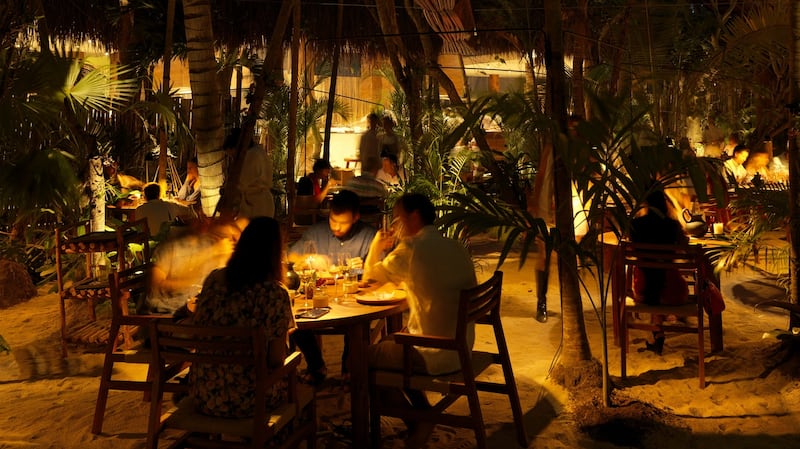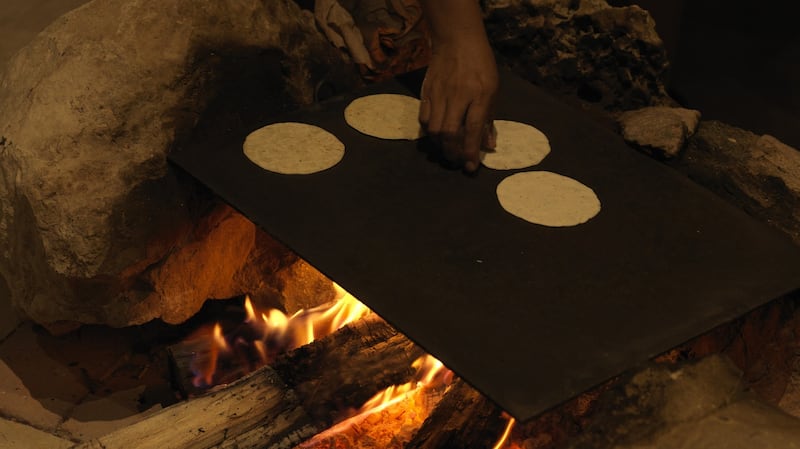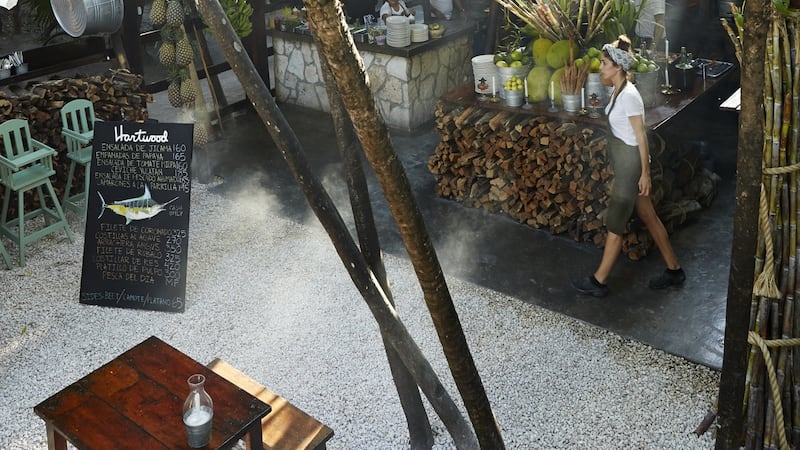Salt is the only thing I can taste at first in Noma Mexico. Over-seasoning. I lick my chops. A salty amuse bouche. Although it's not over-seasoned by a heavy Scandi hand, it's a briny mouthful from a dip in the ocean minutes before my dinner.
I suspect I’m not the only crunchy haired Noma diner in Tulum that night. Before dining at most long-haul destination restaurants, best practice is to arrive air-conditioned and hungry after one final cocktail within walking distance.
But the hypnotic call of $4 beach margaritas and the flashing green and blue wave machine of the Caribbean meant that I'd gone directly from ocean to plate without even showering, despite usually being just one plastic fork away from Jack Nicholson's character from As Good As It Gets.

But tea-time in Tulum means mercury in the 30s and supercharged with 80 per cent humidity, and this restaurant has no air-conditioning. This restaurant also has no walls or roof, and a sand floor. Dining with bare toes in the cool sand under the table, surrounded by jungle and screeching birds, being met on arrival by a towering centrepiece of spectacular local fruits and vegetables – I could be a guest at Carmen Miranda and Tarzan's wedding.

Irish crew
Regardless of Noma's berth it has always had Irish in its crew. I briefly meet a young Irish woman called Sam Hunt, darting between the trees with plates, introduced to her by one of Ireland's overseas shooting-star chefs, Cúán Greene.
The last time I met Greene was in Copenhagen’s Geranium restaurant last year. Geranium’s Greene was in full dress uniform, stiff whites, tall toque in a space seemingly designed for selling trophy kitchens to millionaires. Today he’s – as always smiling, but serious – in damp khakis with dramatically burnt paws, as apart from one induction hob for oil, everything here is cooked over fire. His station is a tricked-out medieval grill with pulleys and levers over naked flames.
“Geranium was an amazing experience but Noma feels like home,” he says. He had been in early that morning to put the water on, over the fire, before beginning the marathon prep for his dish – whole grilled pumpkin with a kelp and avocado fudge.
Mexico’s seemingly never-ending supply of fresh ingredients couldn’t be further from Nordic sparseness. “I’m looking at these pictures from home, updates from chefs,” says René Redzepi, Noma’s head chef, “and they’re like ‘Hey, we got chickweed. We have ramps.’ One ingredient. One day here we got 17 types of guanábana [a type of fruit]. And in Mexico if it’s edible they’ll have done something delicious with it.”

Greene whizzes me around the kitchen and its Viking camp fires, past four traditionally dressed Mayan women, who are crafting 90 perfect maize tortillas per hour over firewood. These superhumans are not a token gesture, or for show. Even Noma’s chefs can’t do better than a third of that.
Controversy
So is Noma serving Mexican food? No. Cultural appropriation? Of course it is. Noma Mexico caused more than some controversy, mostly divided between those who hadn’t dined there and those who had (universally positive), with the focus being the wealth gap between diner and locals.
The idea of a meal devoted to local traditions and ingredients that is being prepared and consumed mostly by people from somewhere else was problematic
The New York Times' critic Pete Wells who controversially decided not to review Noma Mexico said, "The idea of a meal devoted to local traditions and ingredients that is being prepared and consumed mostly by people from somewhere else" was problematic. Jonathan Gold, the LA Times' Pulitzer prize-winning critic, did make the trip and loved everything about it. He said, "It may be like criticising Francis Ford Coppola for filming [Apocalypse Now] in the Philippines or VS Naipaul for setting a novel in Africa: Redzepi is creating something that otherwise would not exist. Beauty and conflict are often intertwined."
The whole point of Noma Mexico is not the painter, it is the subject, it is Mexico. This is a painter abroad, recording and examining, using someone else’s palette to inspire his palate to create bold new edible images that are personal, not universal.
“Complex is a word that you can call all Mexican food,” says Redzepi who has been coming to this peninsula for four to six weeks at a time for over a decade. “I don’t find it simple. I find it really layered and very complex.”
Noma has always been a challenge, like going to a Beckett play. There are some laughs, sure, but mostly, if you have been paying attention, you are as exhausted as you are enlightened by the end of it, and not ready to go back any time soon. At Noma that has mostly meant some challenging textures, temperatures and flavours. Noma Mexico was different – it was a killer edit of everything that Noma has learned from four continents and 14 years, distilled into a sharp and delicious flavour wallop, all over in just over two hours. I’d have gone back the next night.
Journey to Noma
My road to Noma had begun weeks earlier in Baja California after a short, ill-informed stop in Tijuana. I wasn't expecting much as I know that town well. There are some good food things happening there but even now one wrong turn puts you in a real life Sicario scenario.
Mexico city is a monster trip but Baja's Mexican wine renaissance is an over-the-border version of Napa, only less groomed and more craic. They have been producing wine there for hundreds of years. Valle de Guadalupe is a lovely introduction to the sophisticated, bullshit-free farm-to-table reality of Mexican food and drink tourism.
You see it in the generosity of the food and wine at Laja, where you eat and drink their own garden; at El Mogor, where Drew Deckman cooks all his own produce (olive oil, lamb, beef, eggs, herbs, greens) over wood on an open hearth; in Ismene's field kitchen at the Tres Mujeres vineyard.
Between some exceptional wine and ridiculously good, interesting cocktails, everywhere I went I drank well – too well
A small zone physically, the wine valley covers only about 35sq miles but there are now almost 130 stops to visit between wineries, markets and restaurants. Between some exceptional wine and ridiculously good, interesting cocktails, everywhere I went I drank well – too well. Mexican drinks are world beating; this is the biggest beer exporter on the planet, and I had some great and bonkers wines in Valle de Guadalupe, quality tequila and precious smoky mezcal fed into cocktails and glasses of every size.
From Baja I went south to the colonial city of Oaxaca, with its crimson chilli sauce, famous moles, and sublime coffee made with local beans, then on to Holbox, a shoeless Caribbean island where a third of the locals fish for a living and everybody seems to party, seven days a week.
I landed from Holbox into Tulum and onto the sole jungle road that doubles as a catwalk for the coastal 30-something Americans. Everywhere the roadside restaurants' open fires, ovens and grills add a dry ice vibe that could be the VIP section of a jungle Coachella. A smoky strip made food-famous by Erik Werner and Mya Henry of Hartwood, brilliant New Yorkers who fled NYC ended up there, bringing half the food world chasing after them.

Tulum is an easy place to first dip your toe and tongue into this deeply flavoursome ocean of real Mexican food. Break for forays to magical Mayan ruins, diving with whale sharks, propping up a makeshift bar with a cocktail made from local fruit and plants, or sit on your backside on the beach planning all the above.

This trip was different. Noma won’t be travelling again for a couple of years, if ever. After Mexico they return to Denmark to no Noma, no restaurant and no guarantees. Noma 2.0 opening is a long way away and, as Redzepi says, “This will be a tough act to follow”. It will be good fun watching him try though.
Valle de Guadalupe information
Getting there
For Baja, Aer Lingus flies direct to LA. Climatise in LA and head south. There are a couple of car-rental companies that let you cross the border (about 2½ hours from LA) or get the train from LA to San Diego, before getting the tram, the San Diego Trolley, or Ubering to the border, walk across and have a driver from your Baja hotel spirit you down the other Pacific Coast Highway to Ensenada and Valle de Guadalupe.
Where to stay
La Villa del Valle, a beaut of a place owned by Eileen and Phil Gregory along with chef Diego Hernandez. As well as their inn, they own a decent winery and the brilliant Corazón de Tierra, the only Baja restaurant to make Latin America's 50 Best list. And they have a food truck. lavilladelvalle.com
Where to eat
Deckman’s at El Mogor is a simple outdoor hearth where slow food chef Drew Deckman cooks fur and feather solely over local wood. deckmans.com
El Pinar de 3 Mujeres is a dreamy field kitchen where Wonder Woman Ismene Venegas and her Amazonian family pair local food with their own wines from the vineyard that surrounds them
facebook.com/IsmeneCocinaEn3Mujeres
Tulum
Getting there
For Tulum use Kayak or Skyscanner to snag the fastest and cheapest route via London, Madrid, Atlanta, Manchester, or wherever, to Cancún. Transfer (try to share a luxury mini bus or car with someone to lower costs).
Where to stay
This is a low-rise eco-friendly dream. The new Casa Ganesh has a Japanese feel with rooms right on the beach and is just 20 feet from Hartwood.
casaganeshtulum.com
Where to eat
On the jungle road drag Arca. Like Hartwood but possibly better.
arcatulum.com
Hartwood: Queue with a cocktail in your hand from the new little bar across the road. Wednesday to Sunday, dinner only.
hartwoodtulum.com
In town
Honorio. Above all start with a breakfast of cochinita pibil or any tacos at the legendary Taquería Honorio in town. It opens only until 1:30pm. Mandatory.
facebook.com/taqueriahonorio/











